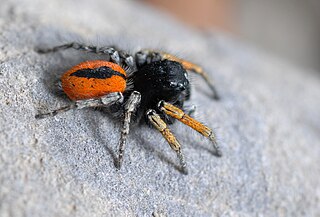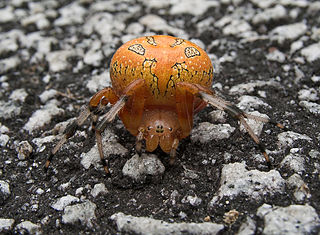
Philaeus chrysops is a species of jumping spider (Salticidae).

Araniella cucurbitina, sometimes called the "cucumber green spider", is a spider of the family Araneidae.

Titanoeca is a genus of spiders that occurs mainly in Eurasia, with three species found only in North America. One species has a holarctic distribution, and T. guayaquilensis is endemic to Ecuador.
Goeldia obscura is a spider species from Colombia and Peru. It is not to be confused with Titanoeca quadriguttata from Europe; both shared the name Titanoeca obscura, but at different times. While G. obscura was never cited as T. obscura since its original description in 1878, T. quadriguttata was cited as T. obscura in various papers from 1932 to 1993, and can be found under this name in later, non-scientific works.

The anatomy of spiders includes many characteristics shared with other arachnids. These characteristics include bodies divided into two tagmata, eight jointed legs, no wings or antennae, the presence of chelicerae and pedipalps, simple eyes, and an exoskeleton, which is periodically shed.

Larinioides cornutus, the furrow spider, furrow orb spider, or foliate spider is an orb-weaver spider with Holarctic distribution.
Lophostica mauriciana is a species of spider in the family Salticidae. It is found only in the islands of Mauritius and Réunion in the western Indian Ocean.

Evarcha arcuata is a species of jumping spiders with a palearctic distribution.

Araneus marmoreus, commonly called the marbled orb-weaver, is a species of spider belonging to the family Araneidae. It is sometimes also called the pumpkin spider from the resemblance of the female's inflated abdomen to an orange pumpkin. It has a Holarctic distribution.
Neischnocolus is a genus of spiders in the family Theraphosidae. It was first described in 1925 by Petrunkevitch. The genus Ami was separately described in 2008, but was later discovered to be a junior synonym of Neischnocolus. Species are native to Central America and northern South America.

Zygoballus sexpunctatus is a species of jumping spider which occurs in the southeastern United States where it can be found in a variety of grassy habitats. Adult spiders measure between 3 and 4.5 mm in length. The cephalothorax and abdomen are bronze to black in color, with reddish brown or yellowish legs. The male has distinctive enlarged chelicerae and front femora. Like many jumping spiders, Z. sexpunctatus males exhibit ritualized courtship and agonistic behavior.

Rugathodes sexpunctatus is a minute species of spider in the family Theridiidae, the cobweb or tangle-web spiders. This family includes the medically important genus Latrodectus—the widow spiders. The species in the genus Rugathodes are too small to be dangerous to humans. Very little is known about most species in this genus.
This glossary describes the terms used in formal descriptions of spiders; where applicable these terms are used in describing other arachnids.

Callobius severus is a species of spider found in parts of the United States and Canada. Individuals reach roughly 19 mm (3/4") in size, with males typically appearing smaller than females. Cephalothorax and legs are reddish to dark brown and the abdomen is dark to light grey with fine hairs, often appearing with large, bilaterally mirrored paler spots. Males feature large, extended palps with prominent projections.

Agelena labyrinthica is a species of spider in the family Agelenidae.

Progradungula otwayensis, commonly known as the odd-clawed spider, is a species of cribellate spider endemic to the Great Otway National Park of Victoria, Australia. It is one of only two species in the gradungulid genus Progradungula.

Drassodes cupreus is a species of spider in the genus Drassodes, family Gnaphosidae. A ground-living nocturnal hunter, it spends the day in a silken retreat.

Theridiosoma gemmosum is a species of spider in the family Theridiosomatidae, known as ray spiders. It is widely distributed in the Holarctic region. A small spider with a shiny globular abdomen, it constructs a conical orb web.

Heliophanus cupreus, the copper sun jumper, is a species of jumping spider belonging to the family Salticidae.

Ordgarius sexspinosus is a species of spider in the orb-weaver spider family Araneidae, found from India to Japan and Indonesia. O. monstrosus is a bolas spider. Rather than using a web, adult females catch their prey by using a line with one or two sticky drops which they swing.
















